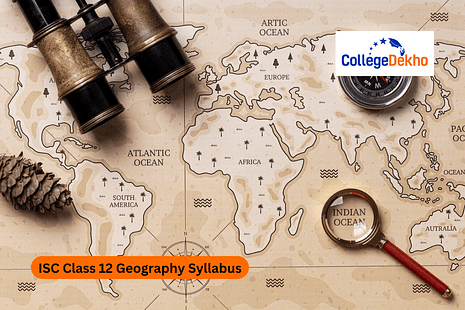- ISC Class 12 Geography Syllabus 2024-25: Course Structure
- ISC Class 12 Geography Syllabus 2024-25: Chapter-wise
- ISC Class 12 Geography Question Paper 2024-25
- ISC Class 12 Geography Deleted Syllabus
- ISC Class 12 Geography Books
- How to Download ISC Class 12 Geography Syllabus 2024-25?
- ISC Class 12 Geography Preparation Tips
- Faqs


Never Miss an Exam Update
ISC Class 12 Geography Syllabus 2024-25:
The students preparing for the Class 12 Geography exam can check the detailed syllabus here. The CISCE has released the syllabus on the official website. There are 6 units in the Geography syllabus. All the units are further divided into different chapters. Students can check the topics in detail and prepare for the board exams. The syllabus also includes the marks for each of the chapters. In addition to it, there will be questions related to the map. For more details related to the ISC Class 12 Geography Syllabus 2024-25, students can thoroughly go through the article.
Also Read -
ISC Class 12 Syllabus 2025
ISC Class 12 Geography Syllabus 2023-24 PDF Download
ISC Class 12 Geography Syllabus 2024-25: Course Structure
Check the course structure of te syllabus from the below given table:
INDIA IN THE WORLD’S CONTEXT |
|---|
1. Physical Environment |
(i) Locational setting - India (ii) Structure of India (iii)Climate: India (iv) Natural vegetation |
2. Population and Human settlements |
(i) Population of India compared to six countries (ii) National and State level patterns of population distribution. (iii)Pattern of population growth in the last three decades; implications for development. (iv) Migration trends over the last 25 years. (v) Demographic attributes at National level (vi) Rural settlements (vii) Urban settlements |
3. Resources of India and their Utilization |
(i) Need for environmental management vis-àvis development. (ii) Land resources (iii)Water resources and types of irrigation. (iv) Agriculture: Types, development and problems. (v) Fishing in India (vi) Sources of Energy |
4. Infrastructural Resources (Development of Transport and Communication). |
(a) Railways, Roadways, Water transport (inland and coastal), Air transport, Pipelines - these modes of transport are to be studied with regard to – (b) Communication – importance of communication in rural development and its policy. Importance of infrastructure as key to the development of an industrial economy. |
5. Industries |
(a) Study of the location and distribution of important industrial centres; a general comparison of disparities. (b) Major industrial regions – factors governing their growth. (c) Location, production and growth of the following industries: (d) Tourism industry |
6. Regional Economic Development |
Map Work
- Locational setting of India
- Plateaus
- Water Bodies
- Plains
- Peaks
- Mountains
- Lakes
- Rivers
- Population
- Resources of India
- Climate of India
- Agriculture
- Industries
- Minerals
- Transport
- Ports
- Hinterland
ISC Class 12 Geography Syllabus 2024-25: Chapter-wise
The chapter wise ISC Class 12 Geography syllabus 2024-25 has been provided below:
Paper - I: Theory
INDIA IN THE WORLD’S CONTEXT
- Physical Environment
(i) Locational setting - India: size and area. Present importance of the location of India with reference to the Indian Ocean Rim countries and the Northern and Western frontiers.
Extent, position with reference to latitude and longitude, length of coastline and frontiers with neighbouring countries. The locational advantages of India in the Indian Ocean and as a subcontinent.
(ii) Structure of India - Geological formation, relief and drainage; major physiographic divisions and their characteristics.
(a) Outline of the geological evolution and structure: Names of the main Standard and Indian geological eras with reference to Indian Geology. Geological evolution of: the Peninsular Plateau, the Himalayas and the Great Plains. Difference between the Peninsular Plateau and the Himalayas.
(b) The three-fold physiographic divisions: the Himalayan mountain complex, the Indus-Ganga-Brahmaputra Plains and the Peninsular Plateau.
- Himalayan mountain complex: (Orthoclinal structure)
The three parallel ranges, the northwest and northeast offshoots, comparison between Western and Eastern Himalayas. Regional divisions of the Himalayas (Kashmir/ Punjab Himalayas, Himachal/ Uttranchal/ Kumaon Himalayas, Nepal Himalayas, Assam Himalayas).
- Indus-Ganga-Brahmaputra Plains
The relief features – bhabar, tarai, bhangar, khaddar, doabs. Regional divisions of the plains: Rajasthan plain (the Great Indian desert), Punjab plain, Ganga plain, Brahamaputra/ Assam plain).
- The Peninsular Plateau
The Malwa plateau, Chotanagpur Plateau and Deccan Plateau: the relief features - badland, Western Ghats, Eastern Ghats, Aravalis. Comparison between the Western Ghats and the Eastern Ghats.
- Coastal Plains
Comparison between Western and Eastern Coastal Plains and their divisions. The relief features: Lagoons, deltas.
- Islands
Difference between Andaman and Nicobar and Lakshadweep islands.
(c) Drainage (i.e. rivers) and drainage systems: Names and sources of the main rivers (Ganga, Yamuna, Indus, Sutlej, Brahmaputra, Mahanandi, Godavari, Kaveri, Krishna, Narmada, Tapi).
Comparison of Himalayan and Peninsular rivers.
(iii) Climate: India - Factors affecting India’s climate: Temperature - factors affecting temperature. Atmospheric pressure conditions during the year; origin and mechanism of the monsoon, Jet streams, Southern Oscillations; wind and rainfall distribution during the year; characteristics of the four main seasons - hot and dry, hot and wet, cool and dry, cool and wet with reference to temperature distribution in north and south India, pressure, wind conditions – distribution of resultant rainfall; variability of rainfall, incidence of droughts and floods. Temperature and rainfall graphs of Mumbai, Delhi, Kolkata, Chennai, Jaisalmer and Leh.
Role of various factors affecting Indian climate – latitudinal extent, distance from the sea, northern mountain ranges, physiography, monsoon winds, upper air circulation, western disturbances and tropical cyclones, southern oscillation, El Nino; understanding of the concept and mechanism of monsoon; Indian Monsoonal Regime – onset, rain bearing system, break in the monsoon, retreat of the monsoon;
Seasons of India - with reference to temperature, pressure distribution, wind systems and local winds (loo, kalbaisaki/ Norwesters, Mango showers; explanation of the variability of rainfall in different areas over different seasons.
Droughts and Floods - meaning, causes, affected areas and mitigation programmes. Temperature and rainfall graphs of Mumbai, Delhi, Kolkata, Chennai, Leh and Jaisalmer.
(iv) Natural vegetation:
Forest - area covered, importance, use, misuse and potential both for exploitation and conservation. Present forest policy.
Distinction between vegetation and forest, virgin vegetation; factors affecting vegetation.
Importance of forest to man; Impact of human activity on vegetation. Forest area and forest cover in India. Forest Conservation – need, Social Forestry (Agro forestry, community forestry, commercial farm forestry, non-commercial farm forestry, urban forestry); Forest Conservation Movement: Van Mahotsav, Chipko Movement.
National Forest Policy (1988): Objectives of the Forest Policy.
- Population and Human settlements
(i) Population of India compared to six countries - China, Australia, USA, Canada, Russia and Brazil. Population of India as compared to the other six countries with reference to percentage of world population and India’s position in the world.
(ii) National and State level patterns of population distribution - Definition of census. Index of concentration (highest and lowest index of concentration as per the latest census), density of population – arithmetic and physiological.
Spatial distribution of population in India and explanation of the factors influencing it – landforms, climate, accessibility and level of development that result in this pattern. Comparison of the density at the State level and factors influencing it.
(iii) Pattern of population growth in the last three decades; implications for development - Meaning of terminologies such as population, birth rate, death rate, population growth rate, natural growth rate and migratory growth.
Population growth of India at national level – trends of 1921, 1951 and 1981 to the latest Census. Demographic characteristics of India at the National level- birth rate, death rate, and natural growth rate from 1991 to the latest Census.
Drawing general conclusions about the: Impact of rapid growth rate on economic development, on environment; need for planned development (to maintain the ecological balance).
(iv) Migration trends over the last 25 years.
Explanation of the important terms – stepwise migration and migrant, push and pull factors.
Types (National and International migration, inter migration and intra migration.
Streams of migration: (rural-rural, ruralurban, urban-urban and urban-rural).
Causes for migration - natural, economic, political and social.
(v) Demographic attributes at National level - Trends and patterns of: 1. Rural urban population 2. Age and sex composition 3. Literacy levels 4. Working and nonworking population; implications for development.
Study of the causes and trends of rural urban composition, age and sex ratio, literacy level, working and non-working population at the National level (highest and lowest figures for each of the above) in the latest census. Implications for development.
(vi) Rural settlements - Types and patterns in hill areas, plains and coastal locations. Distinction between Rural and Urban settlements; Rural and Urban Population. Factors affecting the types (distinction between compact and dispersed) and patterns (linear, circular, star shaped, rectangular, shapeless) of rural settlements in plains, coastal areas, mountains and plateau areas.
(vii) Urban settlements - Size, classification of towns as per the latest census. Definition of an Urban area according to the latest census; Urban agglomeration, conurbation, urban sprawl. Factors that influence the growth of urban centres in India. Problems and advantages of urban growth- slums.
- Resources of India and their Utilisation
(i) Need for environmental management vis-àvis development.
Understanding that from the development point of view, environment may mistakenly be seen as a ‘resource’ to be exploited, whereas, environment needs to be viewed as a ‘capital’ that needs to be managed carefully.
(ii) Land resources: Land use pattern in India – quality of cultivable land, size of land holdings.
Defining the term land resource; its importance and problems. Land use pattern – net sown area, area sown more than once, forests, land not available for cultivation, permanent pastures and other grazing lands, land under miscellaneous tree crops, culturable (cultivable) waste, fallow land, quality and size of cultivable land holdings. Methods to reduce fragmentation of land holdings.
(iii) Water resources and types of irrigation.
Water Resources: Their demand and utilization. Types of water resources: surface and ground water.
Meaning, importance and need for irrigation in India.
Sources of irrigation:
Modern methods: sprinkler irrigation, drip irrigation, Perennial canals - Advantages and disadvantages. Use and misuse of water for irrigation. Overwatering - reasons and regions affected by it; dangers of overwatering; Conservation of water resources including their management; rain water harvesting.
(iv) Agriculture: Types, development and problems.
(a) Wet and dry farming, crop rotation, intensity of cropping, problems of Indian agriculture; use of technology in agriculture. Modern inputs, change over from subsistence to commercial agriculture, need for Green Revolution. Diversifying Indian agriculture – importance of animal husbandry.
Wet and dry agriculture: Crop rotation. Intensity of cropping – concept and crops associated; problems of Indian agriculture; Use of new technology – Green revolution: Need, second green revolution - its strategies. Diversification of Indian agriculture – Animal Husbandry: meaning and its importance in Indian Agriculture.
(b) Study of crops:
(i) Conditions of growth (soil, temperature, rainfall requirements, crop seasons. (ii) World production and India’s position. (iii) Major producing States in India and their rank as producers of the following crops:
Food grains – Rice, Wheat, Coarse grains – Sorghum (Jowar, Maize), Pennisetum (Bajra or Camboo), Eleusine (Ragi), Pulses.
Commercial and Industrial crops – Coffee, Tea, Cotton, Sugarcane, Jute, oilseed cultivation in India particularly of Groundnut, Coconut.
Conditions of growth: For each crop, the type of soil, temperature range, rainfall range, the crop seasons are to be done. Main areas of growth of the above crops and reasons for growth are to be studied. Name of the leading producer (country) in the world for each of the above crops (Food grains, commercial and industrial crops) and India’s position in the world.
Importance of Market Gardening and Orchard Farming – reasons and trends in development in recent years.
Self-explanatory
(v) Fishing in India
Methods, factors affecting the importance and development, fishing ports and markets, need and methods of fish conservation. Understanding of marine and inland fisheries; deep sea and inshore fishing; pelagic and demersal fishing should be done. Problems affecting fishing in India. Two fishing centres and two types of fishes of each coastal State in India should be studied.
(vi) Sources of Energy
(a) Minerals and power resources. Distinguishing between metallic and non-metallic minerals; ferrous and nonferrous minerals. Production and distribution (one leading State and one leading centre in each State) of Iron ore, mica, coal, manganese and petroleum; their uses.
The main power resources – Nuclear, thermal, three main centres for generation of nuclear power in India.
(b) Conventional energy sources - fossil fuels, potential (Indian context) and limitations of each source, methods of harnessing and environmental consequences of their use.
Conventional energy sources:
Coal, Petroleum-their potential and limitations in India. Environmental concerns with regard to their use (global warming, thermal pollution in waters, fly ash, atmospheric pollution, etc.).
(c) Non-conventional energy sources - types of non-conventional sources (bio-mass, solar, wind, ocean, hydel, geothermal), potential (Indian context); their environmental consequences; need to promote non-conventional energy sources.
- Advantages and limitations of each nonconventional energy source.
- Uses of these energy sources and distribution.
- Understanding the need to promote nonconventional energy sources.
- Infrastructural Resources (Development of Transport and Communication)
(a) Railways, Roadways, Water transport (inland and coastal), Air transport, Pipelines - these modes of transport are to be studied with regard to –
Natural and economic factors that govern their distribution; density and growth.
The present position, areas well and poorly served by each mode.
Problems – comparative advantage of each mode of transport, national goals to be achieved in the development of modes of transport (The Golden quadrilateral - its north-south and east-west corridor).
Ports (Mumbai, Chennai, Kolkata, Kochi), their location and advantage; major exports and imports of different ports. Nature and direction of trade from the ports. International trading patterns and products in the last five years.
Distinguishing between harbour and port; natural and artificial harbours. Location of major ports in India and their advantage; main items of export and import from different ports and the patterns in the last five years.
(b) Communication –
importance of communication in rural development and its policy. Importance of infrastructure as key to the development of an industrial economy. Modern means of communication - satellites and remote sensing - Geographic Information Systems (GIS), cellular phones, radio, Doordarshan, internet; the difference between mass communication and telecommunication.
Also Read
-
ISC Class 12 Previous Year Question Paper
- Industries
(a) Study of the location and distribution of important industrial centres; a general comparison of disparities. Self-explanatory
(b) Major industrial regions – factors governing their growth
Reasons for the spread of industrial areas: Understand how the distribution of heavy and consumer industries varies in the different regions; understanding why certain industries are more in a particular region.
Major Industrial regions: Mumbai-Pune, Hooghly, Bengaluru-Tamil Nadu, Gujarat, Chota Nagpur, Vishakhapatnam-Guntur, Gurgaon-Delhi-Meerut. Factors governing the growth of the above to be studied.
(c) Location, production and growth of the following industries:
(i) Agro based industries – Sugar, cotton textile Sugar Industry: Maharashtra (Ahmednagar and Pune), Uttar Pradesh (Muzaffarnagar and Saharanpur), Cotton Textiles: Maharashtra (Mumbai and Pune), Gujarat (Ahmedabad and Surat).
(ii) Mineral based industries – Iron and steel, Petrochemicals, including refineries.
The following industrial centres of each industry are to be studied.
Iron and Steel:
TISCO (Jamshedpur), Vishweshvarya Iron and Steel Plant (Bhadravati), Bhilai Iron and Steel Plant (Bhilai), Rourkela Iron and Steel Plant (Rourkela), Hindustan Steel Limited Plant (Durgapur), Bokaro Iron and Steel Plant (Bokaro), Salem Iron and Steel Plant (Salem), Vishakhapatnam Iron and Steel Plant (Vishakhapatnam).
(Integrated and mini steel plants: meaning, advantages and disadvantages also to be studied.)
- Petro Chemicals:
- UDEX (Koyali), IPCL (Vadodara).
- Oil refineries:
- IOCL (Barauni, Haldia and Digboi), HPCL (Mumbai and Vishakhapatnam).
- Difference between key and footloose industry; industrial clusters and indices to identify industrial clusters.
Maps and sketches of Industrial regions and centres (location of agro based and mineral based industries) should be the basis for explaining the pattern of industrial development.
(d) Tourism industry – Major natural and cultural tourist areas in India. Their special features and level of development - impact on environment and local economy. Tourist flows. Definition of tourism, growth of tourism, advantages of tourism, important places – both natural and cultural. Positive and negative impact of tourism, problems of tourism and measures for developing ecotourism.
- Regional Economic Development
(Case studies)
Case studies will be preceded by a brief understanding of the meaning of development, multilevel planning and planning regions. These case studies will be undertaken with reference to the advantages and disadvantages that have accrued to the people and area - aspects covered will be their geographical location, resource base, developmental history, agriculture and industrial activities, issues of development.
- Area development in Chhattisgarh region – mining, silk industry and farming.
- Electronics industry in Bengaluru– reasons for its development, extent, national and international linkages and problems.
- Growth of Haldia port, its industries and hinterland.
- Map Work
ISC Class 12 Geography Practical Exam 2024-25
In addition to the theory exam, Geography also has a practical exam of 30 marks. Students can check the bifurcation of marks and prepare for the exam accordingly.
- Assignment (project report) - 10 marks
- Practical File (Sessional Record) - 10 marks
- Viva voce - 10 marks
ISC Class 12 Geography Question Paper 2024-25
The ISC Class 12 Geography subject contains two papers theory and practical which carry 70 and 30 marks, respectively. The theory exam will be conducted for 3 hours and students will have to answer subjective questions.
Geography Theory Exam Pattern:
The theory exam will be divided into three sections A, B and C. It will be mandatory to attempt all questions in section A. In sections B and C, students will get a choice between questions.
- Section A: 14 Objective/very short answer questions worth 1 mark each.
- Section B: 7 short answer questions of 4 marks each.
- Section C: 4 long answer questions of 7 marks each.
ISC Class 12 Geography Deleted Syllabus
Check the list of topics that are deleted from the Geography syllabus. The students can check the list of topics and avoid preparing them.
Fundamentals of Human Geography
Chapter | Dropped Topics/ Chapters |
|---|---|
UNIT 1 | |
Chapter 1: Human Geography Nature and Scope | Human Geography Through the Corridors of Time, Last Paragraph of Fields and Sub-Fields of Human Geography |
UNIT 2 | |
Chapter 2: The World Population Distribution, Density and Growth | Table 2.1, 2.2, 2.3, Activity on Migration News Collage, Trends in Population Growth, Doubling Time of World Population, Spatial Pattern of Population Change, Impact of Population Change, Fig.2.2 |
Chapter 3: Population Composition | Full Chapter |
UNIT 3 | |
Chapter 6: Secondary Activities | Traditional Large Scale Industrial Regions, The Ruhr Coal Field, Iron and Steel Industry, Cotton Textile Industry |
Chapter 7: Tertiary and Quaternary Activities | Factors Affecting Tourism, Collage and Activity on Medical Tourism |
Chapter 9: International Trade | Important Aspects of International Trade, Regional Trade Blocs, Figures 9.1 and 9.3 |
UNIT 4 | |
Chapter 10: Human Settlements | Full Chapter |
Appendix 1 | Full Appendix |
India: People and Economy
Chapter | Dropped Topics/ Chapters |
|---|---|
UNIT 1 | |
Chapter 2: Migration: Types, Causes and Consequences | Full Chapter |
Chapter 3: Human Development | Full Chapter |
UNIT 2 | |
Chapter 4: Human Settlements | Classification of Towns on the Basis of Population Size, Fig.4.5, Tables 4.2 and 4.3 |
UNIT 3 | |
Chapter 7: Mineral and Energy Resources | Box information, Fig. 7.4 |
Chapter 8: Manufacturing Industries | Full Chapter |
UNIT 4 | |
Chapter 10: Transport and Communication | Box Information and First Three Lines from page 121 |
Practical Work in Geography—Part II
Chapter | Dropped Topics/ Chapters |
|---|---|
Chapter 2: Data Processing | Measures of Dispersion, Rank Correlation along with All Related Figures |
Chapter 4: Use of Computer in Data Processing and Mapping | Full Chapter |
Chapter 5: Field Surveys | Full Chapter |
ISC Class 12 Geography Books
Following is the list of books recommended for Geography preparation. Students can use these books to understand the concepts.
Name of the Book | Author/Publisher |
|---|---|
ISC Geography for Class 12 | D.R. Khullar |
Oswaal Question Bank Class 12 Geography Book | Oswaal |
How to Download ISC Class 12 Geography Syllabus 2024-25?
Follow the steps given below to download the ISC Class 12 Geography syllabus 2024-25 from the official website of CISCE:
- Step 1: Visit the official web page of CISCE - cisce.org
- Step 2: On the homepage, scroll down to find the option “Library (Publications) and click on it.
- Step 3: A new window will appear on your screen where you will find “ISC Class XII Revised Syllabus 2025 (in selected subjects)”. Click on it.
- Step 4: There will be the ISC 12th revised syllabus 2024-25 PDF of selected subjects. Click on ISC Class 12 Geography syllabus 2024-25 pdf.
- Step 5: A pdf file will open on your screen.
- Step 6: Download and save it for the future reference.
ISC Class 12 Geography Preparation Tips
Students can follow these tips to score good marks in Geography.Complete the syllabus on time - It is the first step towards preparation. Students should complete the syllabus in time. They should try to go through the chapters done in the classroom. Studying simultaneously will help them to clear doubts and prepare in a better way.
Revise syllabus in-depth - Students should start revising the syllabus right after completing it. They can also solve the questions to test their preparation level. A quick revision will enable them to perform better in the ISC 12th Board 2025 exams.
Practice writing answers
- Once the syllabus is completed, students can start practicing the questions. They can write answers and check the topics that need more attention. Accordingly, students can take time for the particular topics and solve more questions related to them.
Also Read -
ISC 12th Preparation Tips 2025
FAQs
Students can score high marks in ISC Class 12th Geography by regularly practicing the questions. This will enhance their answer-writing skills which will help them score good marks.
Students should focus on the ISC Class 12th Geography syllabus from the beginning. They can divide the syllabus into smaller units and complete the syllabus.
You can download the ISC Class 12 Geography syllabus 2024-25 from the official website of CISCE. You can also download the ISC Class 12 Geography syllabus 2024-25 pdf from this page.
There are 6 chapters along with map work in the ISC Class 12 Geography syllabus 2024-25. The detailed syllabus has been given above on this page.
Was this article helpful?















